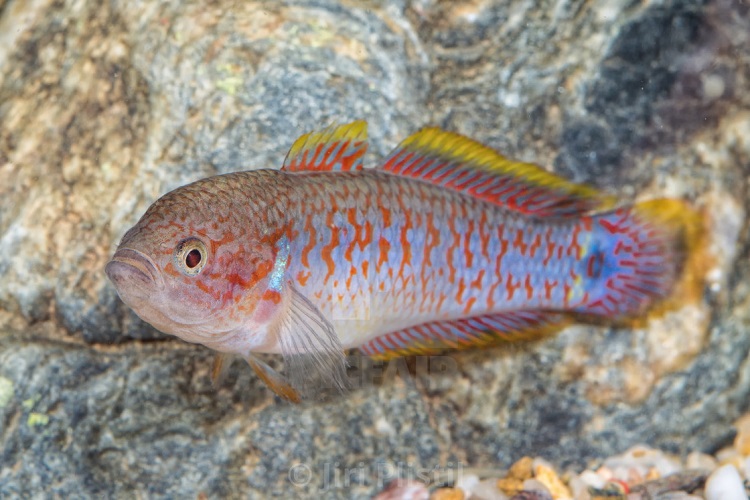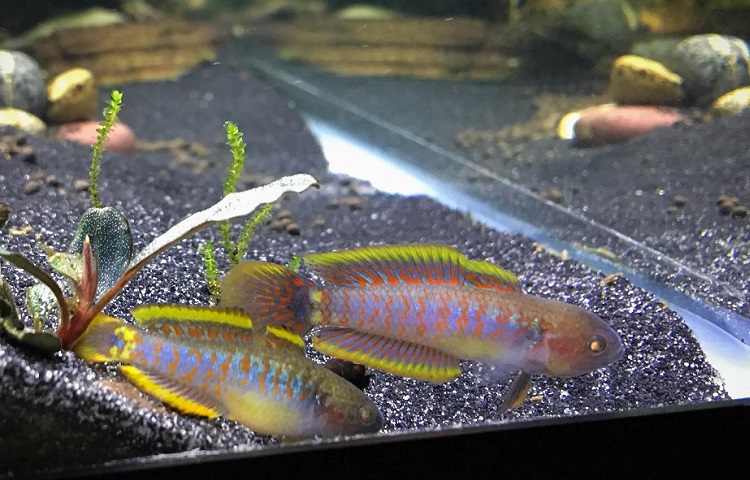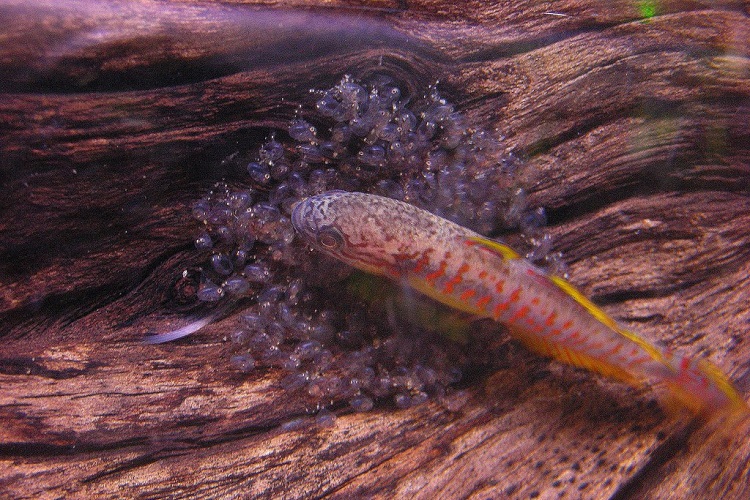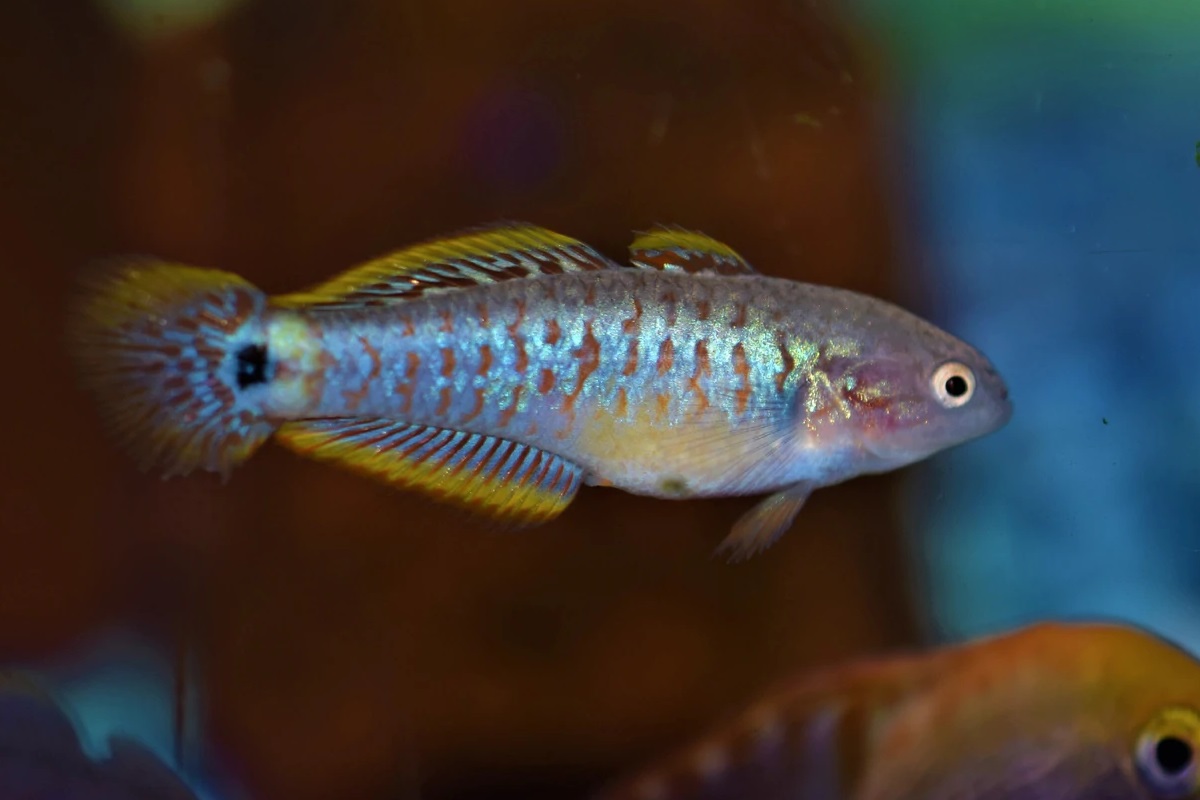Peacock gudgeons (Tateurndina ocellicauda) are known for their bright colors and natural curiosity.
It can be exciting to see these little fish flitting between the foliage of their tank and poking their heads out of a cave system. The best thing is that they are easy to care for and make a great addition to a community tank full of other peaceful species of fish.
But what goes into raising a peacock gudgeon?
This guide will tell you everything you need to know about these beautiful little fish, along with what kind of environment is best for them, what they eat, what disease to look out for, and even how to breed them.
If you’re interested in adding peacock gudgeons to your aquarium, keep reading to learn more.
Contents
What Is a Peacock Gudgeon?

A peacock gudgeon, belonging to the family Eleotridae, is a colorful freshwater fish that is relatively easy to care for and makes a stunning addition to any freshwater aquarium.
They are sometimes also referred to as the peacock goby, despite them not being a part of the true gobies at all.
In the wild, they are found mainly in Papua New Guinea but also in parts of Australia and New Zealand. They prefer shallow bodies of water.
Despite being found in the wild, most peacock gudgeons in stores today are purposely bred for aquariums.
Thanks to their bright coloring, they have become quite popular. They have long slender bodies and rounded heads. Males have a nuchal hump on their heads, while females have a thin black stripe on their fins.
The base color for this fish is anywhere between a silver-blue and electric blue. Along the entire length of the body, there are stripes consisting of red dots. The red is streaked through their fins as well, ending with a thick streak of bright yellow. At the base of their tail is a black spot. Finally, they have a soft yellow belly.
The black spot on their tail, or “eye spot,” is a defense mechanism created in the wild. The idea is that potential predators would see the eyespot and try to eat that, rather than going for the actual head. With this, a peacock gudgeon may only be injured in an attack, or they may get away entirely.
This spot is the entire reason for the peacock name. The spot, along with the blue and red coloring, is reminiscent of peacock feathers.
Peacock gudgeons usually grow to be about inches in length. Females tend to be smaller than the males, usually only reaching about two inches. Males and females can be told apart not only by their size but by the male’s aforementioned nuchal hump and the female’s thin blackfin line.
Lastly, males and females can be told apart by their coloring, as females tend to have many bright colors than males.
In general, they are very peaceful fish. When placed with tank mates, you will hardly ever see them go on the attack. On occasion, you may notice a couple of males sparring with each other, but these mild attacks rarely last for long and are generally never a big deal.
They prefer to live in a small group. Six to eight of these little fish is a perfect number for them. They are naturally curious fish, and you will most often see them exploring their tank among the leaves and decorations that you have placed there.
When they feel truly at home, you may even spot them and their beautiful colors in the open water areas of the tank.
The average peacock gudgeon will live for about four to five years. Compared to some freshwater fish, this isn’t a very long lifespan at all (looking at you, goldfish). For the time that you do have them, peacock gudgeons still make a visually stunning addition to your tank.
Tank Size for Peacock Gudgeon?

Peacock gudgeons don’t require a massive tank. They are small fish, even when you have a group of them. They also don’t feel the need to swim very far.
For these reasons, 15 gallons is more than enough room for a small group of them. Even ten galleons would be a fine minimum tank size. Of course, if you are adding them to a tank of multiple fish, then you will need a bigger aquarium. As a general rule of thumb, the larger the tank, the easier it is to maintain the water quality.
For water parameters, These fish prefer their water slightly on the warmer side. You’ll want to aim for a water temperature that’s anywhere between 72 and 79 degrees Fahrenheit. The pH level can be anywhere from 6.0 to 7.8, though these fish will be most comfortable at a pH around 7.0. Finally, aim for a water hardness of 5 to 12dKH.
Peacock gudgeons love plants. You’ll want an aquarium that is full of live plants for happy, playful fish. In the wild, they will use the leaves as a place to hide whenever they feel threatened. Even when they aren’t hiding, peacock gudgeons will play among the live plants.
That being said, you will want to opt for hardy plants. Anything particularly delicate can be damaged by the energetic fish. Some good plant species to consider for your aquarium include java fern, water wisteria, and anubias.
When setting up their tank, peacock gudgeons also love to have plenty of hiding places. You can use decorations such as rocks and driftwood to give them plenty of little places to tuck themselves away.
You could even consider making a cave system in your aquarium. PVC pipe is an easy way to make a cave system, or you could use carefully placed rocks. Lastly, you could purchase a ready-made cave system.
When it comes to a filter, any basic filter will do. All you need to ensure is that the filter is enough to cycle the tank, given its size. You may also want to consider the outlet of the filtration center.
Peacock gudgeons aren’t very strong swimmers, so you won’t want an outlet that creates a strong current. Aim for something that will make as gentle of a current as possible. Alternatively, you can direct the outlet flow against the wall of the tank to reduce the effect of the outward current, or you could place a decoration in front of the outward current.
Is Sand Substrate Needed

Sand is preferred for peacock gudgeons. When it comes to sand in aquariums, there are plenty of benefits to make it worthwhile.
The main benefit is that many aquarium users find sand much easier to clean and maintain as opposed to gravel. It also looks far more natural-looking. When it comes to the plants that gudgeons prefer, you can use the sand to securely anchor them to the bottom of the tank.
Sand can also be much safer for smaller fish. As peacock gudgeons love to hide and play, they can get hurt in a gravel tank.
Dark sand especially will help the bright colors of the peacock gudgeons pop.
Best Food for Peacock Gudgeon?
The only challenge you’ll have with peacock gudgeons is feeding them. They are notoriously picky eaters and tend to prefer life food over regular fish flakes.
Your best option for these fish is live, fresh food. Some great options are blood worms, brine shrimp, and daphnia. Frozen live food may also work quite well.
You can try dry fish flake food for them, but some aquarists have varying degrees of success. In any case, it is certainly worth a try.
One recommended way to feed these picky little fish is to offer dry food as a staple and occasionally supplement it with live or frozen foods. Live food is always considered the most nutritious for these fish. Not only will it create healthier fish, but you will notice their colors will be more vibrant as a result.
In the wild, peacock gudgeons feast on live insects that come to their shallow peaceful waters.
Peacock Gudgeon Diseases

There are no diseases specific to peacock gudgeons. They are susceptible to a few ailments that are common among most aquarium fish.
Ich – Ich is formed from a parasite named Ichthyophthirius multifiliis. Ich is most easily recognized by tiny white spots on your fish. You can also notice it if your fish is flashing, scratching, missing scales from flashing, lethargic, or multiple fish suddenly die at one time.
The moment you notice ich, you need to quarantine the affected fish in a hospital tank. You can treat them with a copper-based medication until they recover. Also, the water should be changed in between every time you give them medication.
Ich most often occurs in subpar water conditions. This can stress out your fish, creating ich. The best preventative measure is to maintain good quality water for your fish.
Worms and Parasites – There are a few worms and parasites that will go after your fish. The easiest way to tell if your fish has some kind of parasite is if they are rubbing against the decorations as if scratching themselves. Luckily most parasites can be treated with medication.
Hole-in-Head – This head disease can be seen with small pits or sores on the head. They can also lose their appetite and die in later stages. It is transmitted via feces, so the easiest way to prevent it is to maintain good quality water will regular cleaning. In some cases, it is also thought to be caused by a mineral imbalance in the water, most often caused by poor water quality mixed with the presence of activated carbon.
Hole-in-Head is completely treatable with medication. If you notice some of your fish getting it, it is also important to remove any sources of activated carbon from your tank (such as the filter) and do large water changes. Typical water changes may only be a quarter or half a tank. Consider changing out a bit more of the water when dealing with this disease in your fish.
Skin and Gill flukes – Flukes are tiny worms that will latch on to the skin or gills of your fish. In doing so, they will create lesions. Small infestations are usually not a big consideration, though larger infestations will kill your fish. This illness can thankfully be treated with either antibacterial or antifungal medications.
Good and Bad Tank Mates
Peacock gudgeons are peaceful though playful fish that do well in community tanks. As a general rule of thumb, they do best in tanks where there aren’t many outwardly aggressive fish species. Having a couple slightly more territorial fish can be fine, so long as they aren’t of a size to try and eat your little gudgeons.
Peacock gudgeons do well with other gudgeon fish, but that’s not all. Some companion fish that you may want to consider include tetras (like the ember tetra), bumblebee goby, harlequin rasbora, cherry barb, cory catfish, kuhli loach, celestial pearl danios, and Apistogramma.
Some aquarium owners may wonder if peacock gudgeons would work well with betta fish. The answer is, it depends. Bettas can be very territorial and may go after an unsuspecting peacock gudgeon. This is especially true for a male betta and a male peacock gudgeon in a tank together. If you got for a female betta, you might have an easier time of it.
If you want to try pairing these two together, first make sure that your peacock gudgeons have plenty of places to hide. Try to take advantage of a cave system, preferably something that betta fish wouldn’t be able to fit in.
That way, if the betta did get it into its mind to attack, your peacock fish would have a place to hide until things calm down. Once you introduce these fish to each other, just remember to keep an eye on things to see how it goes.
Can You Breed Peacock Gudgeon in Aquariums?

If you’re interested in breeding peacock gudgeons, it is quite easy to do so.
To start out, keep an eye on your gudgeons to find a male and female that seem to like each other as a mating pair. Once you have located them, transfer the pair into a breeding tank. A separate tank will not only keep them safe from other fish, but it will also keep the young gudgeons safe until they are old enough to join the rest of the population.
Much like the main tank, the breeding tank should have places to hide. For the purposes of breeding, it doesn’t need to be anything fancy. A simple PVC cave will do, or even a terra cotta pot.
To encourage your breeding pair to start spawning, first perform a water change. You will then start feeding them high-quality live food rich in protein. This step may take a little while for the pair to be ready to mate.
When they are ready, the male will start to dance in front of the cave. He will flash his scales and flair the pectoral fins.
If the female is also ready for spawning, she will follow him into the cave system that you have made for them. It is inside this cave that the female will lay her eggs. The eggs have a sticky coating that will allow them to be deposited safely where ever the female may choose. In this case, she’ll leave them on the cave walls and then leave.
The male will then fertilize the deposited eggs. It’s the male that tends to the eggs while they are waiting to hatch. He does this by protecting them and fanning them with his tail. After eight to ten days, the eggs will hatch.
Sometimes the male will stay near the young for a little while to ensure they eat their egg sacs. Shortly after, however, he will leave the young to go about his business. Once you notice that the male has left the gudgeon larvae, you can transfer him and the female back to the main tank.
The young gudgeons will remain in and around the cave for the first few weeks of their lives as they won’t be fully able to swim yet. In these early stages, you can give them powdered food and infusoria. Once they are a little larger, you can start giving them brine shrimp. You will want to offer them a constant supply of food to encourage them to grow quickly.
Once the new peacock gudgeons are anywhere between two and four months old, you can transfer them to the main tank.
Conclusion
Peacock gudgeons are beautiful fish that are fun to watch and lovely peaceful creatures. They are easy to keep and maintain, aside from their tendency to be picky eaters.
Once you have an established home aquarium and find out what food they like best, then they are very easy to keep healthy and happy for the rest of their lives.

Ian Sterling, founder of Fishlab.com, began his aquarium journey over 30 years ago, driven by a deep fascination for fish and their diverse personalities. His website, Fishlab.com, is dedicated to making fishkeeping accessible and enjoyable, offering beginner-friendly guidance, expert insights, and a community for aquarists to connect and share experiences.


